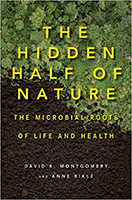 David Montgomery is a professor of geomorphology at the University of Washington, in Seattle. I’m a fan of his work in soil conservation and countering creationism, so I was very pleased to find myself sharing the “honoree” table with him in Vancouver the year before last, at the annual awards luncheon for the National Association of Geoscience Teachers and the Geological Society of America’s Geoscience Education Division. I was there as the Biggs Awardee, while Montgomery received the James Shea Award. In his speech, Montgomery told the group that he was working on a new book, a project he was co-writing with his wife, Anne Biklé. The subject was about how microbes mediate almost everything we hold near and dear. That book is now out. It’s called The Hidden Half of Nature: the Microbial Roots of Life and Health. I just finished the audiobook version of it.
David Montgomery is a professor of geomorphology at the University of Washington, in Seattle. I’m a fan of his work in soil conservation and countering creationism, so I was very pleased to find myself sharing the “honoree” table with him in Vancouver the year before last, at the annual awards luncheon for the National Association of Geoscience Teachers and the Geological Society of America’s Geoscience Education Division. I was there as the Biggs Awardee, while Montgomery received the James Shea Award. In his speech, Montgomery told the group that he was working on a new book, a project he was co-writing with his wife, Anne Biklé. The subject was about how microbes mediate almost everything we hold near and dear. That book is now out. It’s called The Hidden Half of Nature: the Microbial Roots of Life and Health. I just finished the audiobook version of it.
The premise of the book is that microbes really matter, and that most of them matter in a positive way – commensalism and mutualism – even though most of our agricultural and medical practice thinks of “germs” as bad, and worthy of biocide. Using an extended analogy between the functioning of their backyard garden and the functioning of the human body, Montgomery and Biklé explore the science of how healthy microbial ecosystems nurture plant growth, nutrition, and productivity, as well as help regulate immune responses in our own bodies. The journey begins as they transform the weedy bare lot of their Seattle home into a vibrant garden – by bringing in huge quantities of organic material and inoculating it with a compost “tea” of useful microbes. Their plants begin to thrive, and this leads the authors to explore the “rhizosphere” – a zone of intense microbial life surrounding and integrated with plant roots in great detail – detail matched later in the book when, after Anne develops cancer, she delves into a similar realm of microbial/macro-organismal cooperation: the colon. There’s a lot of biochemistry in these sections of the book – right at the threshold of my attention span, frankly. But the larger point is valid and clear: we need to embrace a new perspective on soil health and human health: most microbes serve useful, even critical functions. When we sterilize soil or treat our bodies with antibiotics, we can inadvertently eliminate the good bugs along with the “bad.” These microbes do really important things, including triggering certain immune responses and releasing plant growth hormones. On the tiniest level, it’s fascinating to see how much we are controlled by chemicals produced by organisms that we cannot see.
Topics covered range from the development of nitrogen fixing technology to agricultural micronutrient declines over the past century, to the function of the appendix and the evolution of mitochondria. History of science is covered extensively – the discoveries of the first microscopists; the work of Louis Pasteur; hand washing’s initial rejection by the medical establishment. It’s a broad spectrum of topics, but you never feel like they are deviating too far from their chosen subject. Instead, in examining a complex tapestry of interconnectedness, they focus on a thread at a time. It works.
The book is not perfect – the argument is in places redundant, evidence presented is sometimes anecdotal rather than rigorously controlled, and the narration of how the authors were introduced to certain ideas can be tedious (Stuff like: ‘We went on vacation and went to a park and then stopped at this great little pub for tea, and there I picked up a magazine that had an article in it that captured my imagination, which led me to read other articles,’ etc.) but overall the strengths of the book outweigh these critiques. The language is accessible and straightforward, the analogies are strong and simple, and the overall message’s validity is supported quantitatively and qualitatively from dozens of directions. I’m glad to have read it, and already I can see that it has changed my perspective. When I ate breakfast this morning, I was thinking less about what I wanted to taste and more about what sort of “mulch” I wanted to be applying to my inner “garden” of microbes.
Recommended, especially if you haven’t already read Montgomery’s Dirt, or if you know anyone with diseases that result from chronic inflammation.
